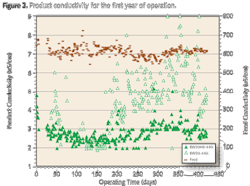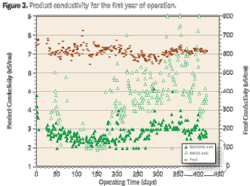Flowmeters Prove Hot Choice in Cold, Cold Sweden
A modern wastewater treatment plant in Stockholm required a flowmeter with a measurement accuracy better than 1% of full scale for its partially filled pipelines. Marc Verwoerd and Helen Danen discuss how the installed solution had to cope with extreme conditions, including the build up of oxygen hydrogen sulfide.
Amajor challenge for the Swedish Käppala Association, responsible for the collection and treatment of sewage from various municipalities, is measuring the flow rate of sewage of various regions due to the wide variations in flow during the day. Not only does water disposal from households and industries fluctuate much during day and night but also a heavy rainfall occasionally leads to a large increase of the supply of influent flowing into the wastewater treatment facility. This results in pipes that are mostly partially filled. A commonly used solution for influent is open channel measurement; however, in this case a measurement in a closed piping conduit was preferred because it enables a safe and clean working environment for its maintenance personnel. The wastewater system runs through tunnels where toxic hydrogen sulfide gas (H2S) is formed. Standard flow meter solutions require the pipe to be completely filled and could not be applied.
Käppala wastewater treatment plant
The association's modern wastewater treatment plant is located in Käppala, Lidingö, an island east of Stockholm in the inner part of the famous Stockholm Archipelago. Wastewater from households in the eleven member municipalities, including a population of 500,000 inhabitants and from hospitals, schools, offices and industries travels through a 60-kilometer system of tunnels and three pumping stations before it enters the wastewater treatment plant. It only takes 24 hours before it leaves the plant again as purified water. The wide stretched area of Stockholm is divided into 24 sub areas from where influent is taken in and wastewater coming in from the various sub areas has to be measured very accurately. The total amount of treated water is approximately 50 million cubic meters per year.
The measurement challenges
The Käppala Association looked for a maintenance free flowmeter solution with a measurement accuracy of better than 1% of full scale for its partially filled pipelines. The flow rate varies strongly during the day and the filling rate of the pipe can be as low as 10% of the pipe size. As the temperature of the wastewater in the tunnels is rather cold, especially in the cold winters of Sweden, fat easily builds up at the pipe walls. The fat build-up creates flow disturbances, resulting in lower measurement accuracy and high maintenance efforts.
The metering installation includes a bypass to prevent wastewater flowing through the flow meter during maintenance to clean the pipe and the flowmeter. Next to the flowmeter manholes have been built for an easy access to the flowmeter during cleaning activities. As one can imagine a flowmeter with internal moving parts was not even considered for this application.
The tunnels, through which the wastewater runs, are built in natural rocks. In the absence of oxygen hydrogen sulfide can be formed resulting the breakdown of organic matter. To arrange for a safe and clean working environment for its maintenance engineers the Käppala Association required that the measurement should take place in a closed system.
Electromagnetic flowmeter for partially filled pipes
The wastewater treatment company chose a solution comprising electromagnetic flowmeters from KROHNE, designed specifically for measurements in partially filled pipes. In total 24 TIDALFLUX meters with various diameter sizes, ranging from DN600 up to DN1000, have been installed in the wastewater collection system. The electromagnetic flowmeter provides reliable measurements with flows between 10% and 100% of the pipe cross section.
The velocity measurement of a TIDALFUX is similar to a conventional electromagnetic flowmeter. In order to calculate the flow rate when the pipe is not full; the TIDALFUX also measures the filling level in the flow tube to determine the wetted area. The measurement velocity and the wetted area are combined in the converter to a matching flow rate. The filling level is measured by means of capacitive plates and high frequency electronics. It uses a patented, non-contact level measurement. The integrated level sensors behind the liner have no contact with the liquid and are therefore insensitive to fat and oil floating on the surface.
combatting a corrosive environment
The process conditions put special requirements on the materials that can be used. The liner has to be abrasion resistant, because debris and dirt in the wastewater can cause wear to the liner. Also the corrosive nature of H2S puts restrictions on the choice of materials. This is particularly the case for the electrodes when they are not always wetted. For that reason the TIDALFUX only has two wetted electrodes that are mounted at a height of 10% from the bottom of the pipe to avoid that in partially filled mode they come in contact with the corrosive H2S environment.
To prevent fat from building up at the transition of the pipe with the flow sensor, KROHNE and the Käppala Association jointly engineered a solution whereby thin walled pipe reducers are mounted at the critical spots. A smooth inner pipe and transition prevents fast contamination and wear due to particles and fat in the wastewater.
Author's note:Marc Verwoerd and Helen Danen are from the KROHNE Product management team.More Water & WasteWater International Current Issue Articles
More Water & WasteWater International Archives Issue Articles

